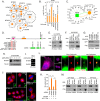Defining the Protein-Protein Interaction Network of the Human Protein Tyrosine Phosphatase Family
- PMID: 27432908
- PMCID: PMC5013315
- DOI: 10.1074/mcp.M116.060277
Defining the Protein-Protein Interaction Network of the Human Protein Tyrosine Phosphatase Family
Abstract
Protein tyrosine phosphorylation, which plays a vital role in a variety of human cellular processes, is coordinated by protein tyrosine kinases and protein tyrosine phosphatases (PTPs). Genomic studies provide compelling evidence that PTPs are frequently mutated in various human cancers, suggesting that they have important roles in tumor suppression. However, the cellular functions and regulatory machineries of most PTPs are still largely unknown. To gain a comprehensive understanding of the protein-protein interaction network of the human PTP family, we performed a global proteomic study. Using a Minkowski distance-based unified scoring environment (MUSE) for the data analysis, we identified 940 high confidence candidate-interacting proteins that comprise the interaction landscape of the human PTP family. Through a gene ontology analysis and functional validations, we connected the PTP family with several key signaling pathways or cellular functions whose associations were previously unclear, such as the RAS-RAF-MEK pathway, the Hippo-YAP pathway, and cytokinesis. Our study provides the first glimpse of a protein interaction network for the human PTP family, linking it to a number of crucial signaling events, and generating a useful resource for future studies of PTPs.
© 2016 by The American Society for Biochemistry and Molecular Biology, Inc.
Figures





Similar articles
-
Proteomic approaches to studying protein tyrosine phosphatases.Mol Biosyst. 2007 May;3(5):308-16. doi: 10.1039/b700704n. Epub 2007 Mar 21. Mol Biosyst. 2007. PMID: 17460790 Review.
-
Use of Dominant-Negative/Substrate Trapping PTP Mutations to Search for PTP Interactors/Substrates.Methods Mol Biol. 2016;1447:243-65. doi: 10.1007/978-1-4939-3746-2_14. Methods Mol Biol. 2016. PMID: 27514810
-
Yeast substrate-trapping system for isolating substrates of protein tyrosine phosphatases: Isolation of substrates for protein tyrosine phosphatase receptor type z.Methods. 2005 Jan;35(1):54-63. doi: 10.1016/j.ymeth.2004.07.008. Methods. 2005. PMID: 15588986
-
Functional studies of protein tyrosine phosphatases with chemical approaches.Biochim Biophys Acta. 2005 Dec 30;1754(1-2):100-7. doi: 10.1016/j.bbapap.2005.09.005. Epub 2005 Sep 29. Biochim Biophys Acta. 2005. PMID: 16226063 Review.
-
A Human Tyrosine Phosphatase Interactome Mapped by Proteomic Profiling.J Proteome Res. 2017 Aug 4;16(8):2789-2801. doi: 10.1021/acs.jproteome.7b00065. Epub 2017 Jul 18. J Proteome Res. 2017. PMID: 28675297 Free PMC article.
Cited by
-
Glycaemic abnormalities induced by small molecule tryosine kinase inhibitors: a review.Front Pharmacol. 2024 Feb 1;15:1355171. doi: 10.3389/fphar.2024.1355171. eCollection 2024. Front Pharmacol. 2024. PMID: 38362147 Free PMC article. Review.
-
Functional annotation of the Hippo pathway somatic mutations in human cancers.Nat Commun. 2024 Nov 21;15(1):10106. doi: 10.1038/s41467-024-54480-y. Nat Commun. 2024. PMID: 39572544 Free PMC article.
-
Protocol for establishing a protein-protein interaction network using tandem affinity purification followed by mass spectrometry in mammalian cells.STAR Protoc. 2022 Jul 19;3(3):101569. doi: 10.1016/j.xpro.2022.101569. eCollection 2022 Sep 16. STAR Protoc. 2022. PMID: 35874475 Free PMC article.
-
Identification of PTPN12 Phosphatase as a Novel Negative Regulator of Hippo Pathway Effectors YAP/TAZ in Breast Cancer.Int J Mol Sci. 2024 Apr 5;25(7):4064. doi: 10.3390/ijms25074064. Int J Mol Sci. 2024. PMID: 38612874 Free PMC article.
-
A proximity-dependent biotinylation map of a human cell.Nature. 2021 Jul;595(7865):120-124. doi: 10.1038/s41586-021-03592-2. Epub 2021 Jun 2. Nature. 2021. PMID: 34079125
References
-
- Tonks N. K. (2006) Protein tyrosine phosphatases: from genes, to function, to disease. Nat. Rev. Mol. Cell Biol. 7, 833–846 - PubMed
-
- Ostman A., Hellberg C., and Bohmer F. D. (2006) Protein-tyrosine phosphatases and cancer. Nat. Rev. Cancer 6, 307–320 - PubMed
-
- Alonso A., Sasin J., Bottini N., Friedberg I., Osterman A., Godzik A., Hunter T., Dixon J., and Mustelin T. (2004) Protein tyrosine phosphatases in the human genome. Cell 117, 699–711 - PubMed
-
- Andersen J. N., Jansen P. G., Echwald S. M., Mortensen O. H., Fukada T., Del Vecchio R., Tonks N. K., and Moller N. P. (2004) A genomic perspective on protein tyrosine phosphatases: gene structure, pseudogenes, and genetic disease linkage. FASEB J. 18, 8–30 - PubMed
Publication types
MeSH terms
Substances
Grants and funding
LinkOut - more resources
Full Text Sources
Other Literature Sources
Research Materials
Miscellaneous

